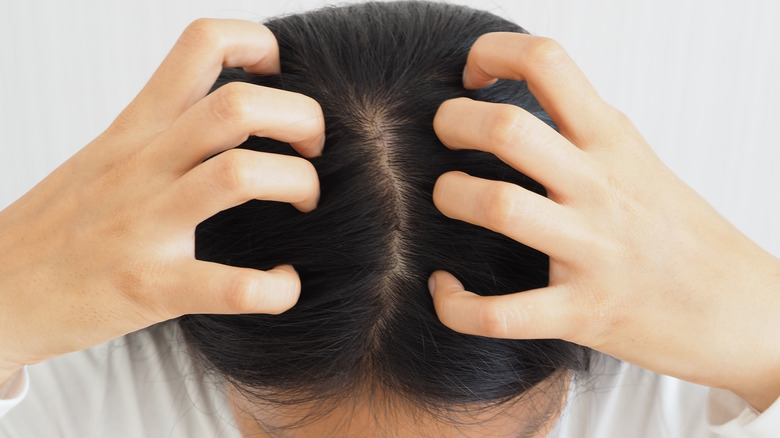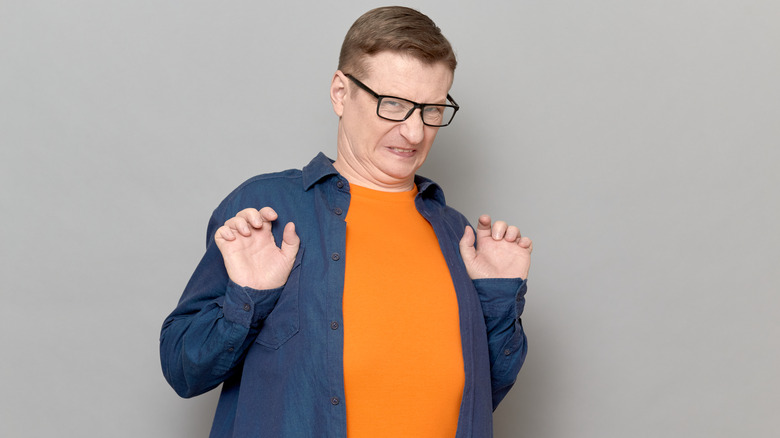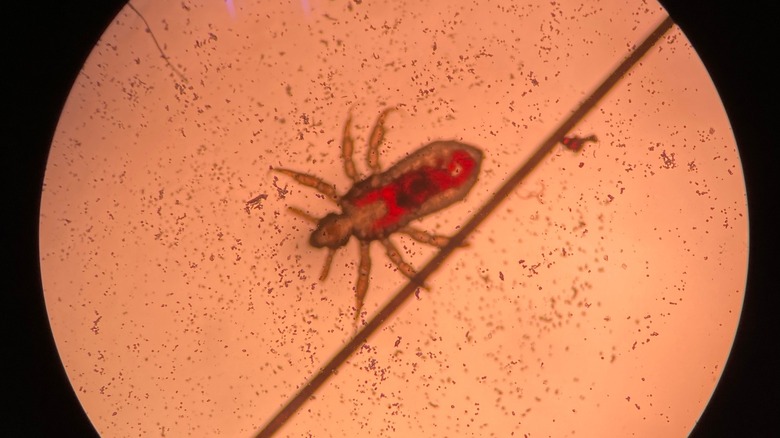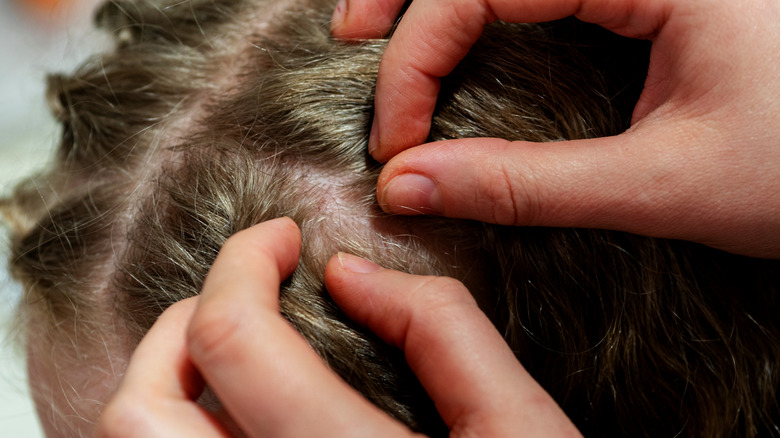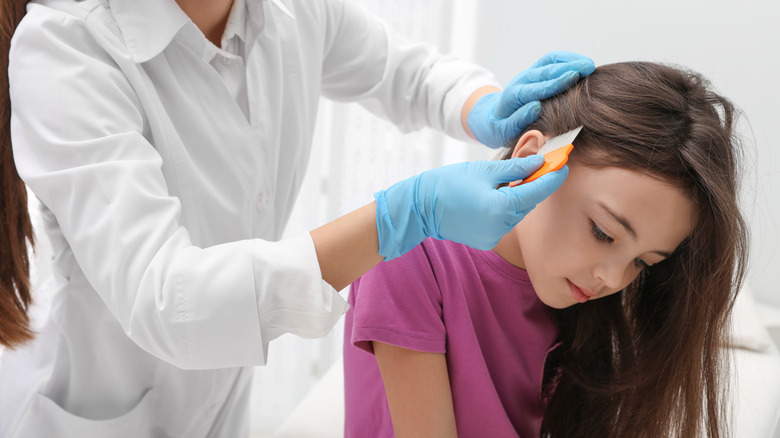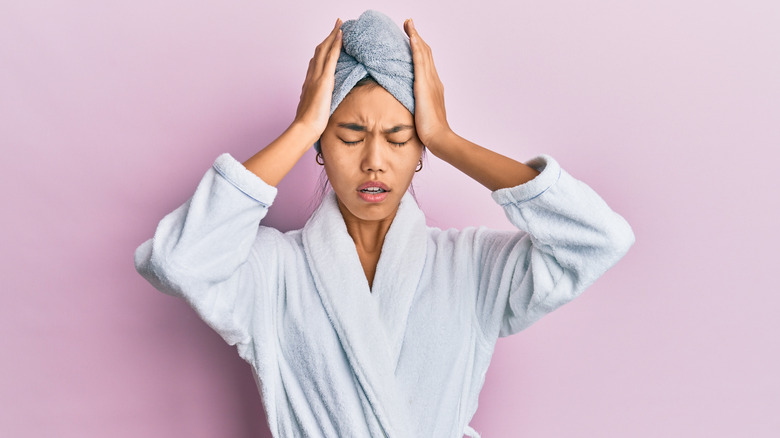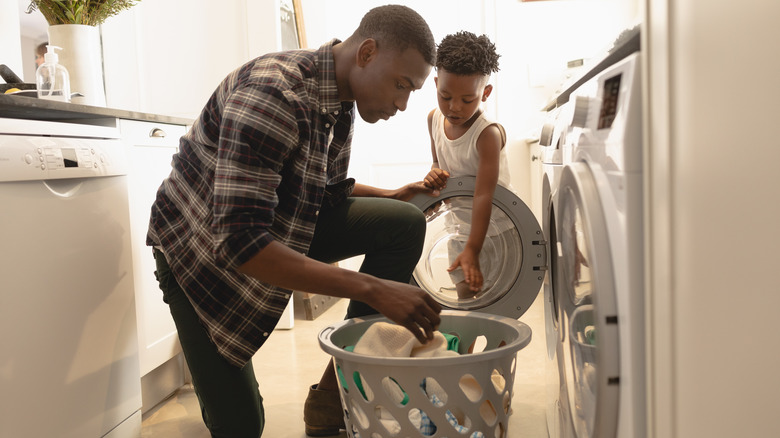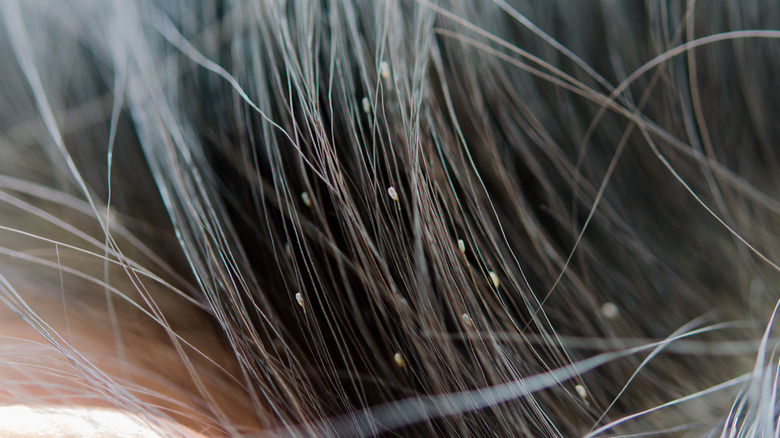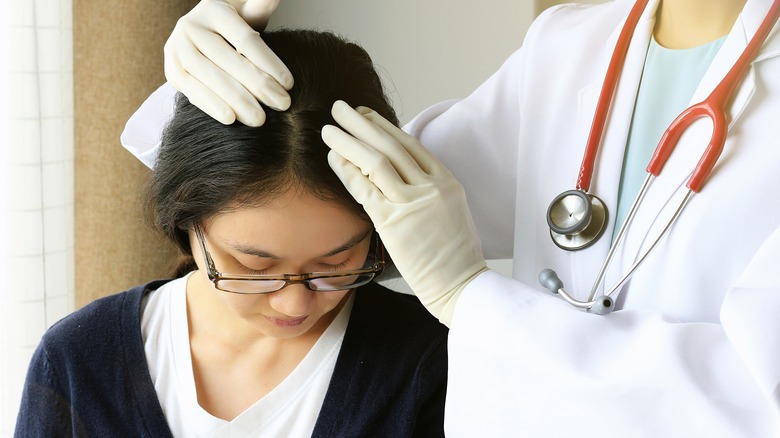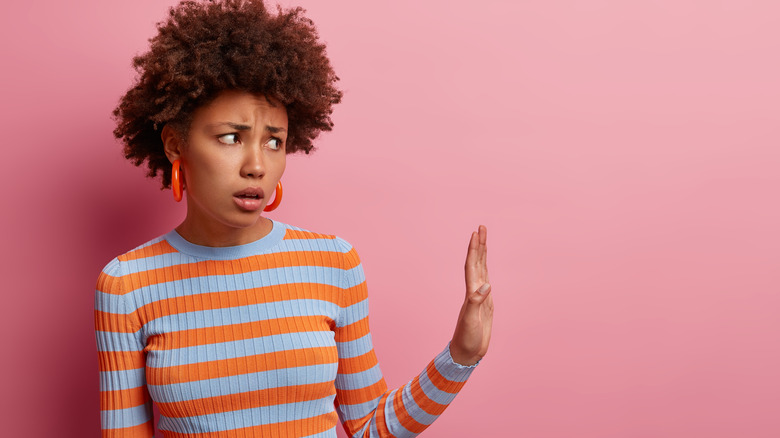Everything You Should Know About Head Lice
Everything you know about lice is wrong. Okay, not everything. But for a pest that's plagued humanity for so long that its very name is an insult, you'd think the humble louse would be better understood by the humans it lives with. Myths about head lice are almost as hard to eradicate as the insects themselves (via Health). They're not a sign of hygiene problems. You can't catch them from pets or animals. And, no, they don't cause any particular health problems.
On the other hand, getting to know lice better means accepting some unpleasant truths: They're good at what they do, which is colonizing your hair, drinking your blood, and laying eggs to make more lice. Some of the popular home remedies you've heard about don't actually work, and not everyone agrees about how to handle lice outbreaks in schools. And that's just the tip of the liceberg.
Keeping lice out of your family's life requires understanding how they operate, so go ahead and give your scalp a preemptive itch — it's time to explore their whole lousy story.
There are three kinds of lice that live on humans
Nature has blessed humans with the companionship of three types of lice: head lice, body lice, and pubic lice. Scalp-dwelling head lice live are the kind that turn up in the hair of schoolchildren, resulting in the dreaded "lice letter." Head lice don't carry disease. Body lice live in clothing and bedding, where they also lay their eggs, and move onto human skin to feed. Their bites are typically found around the neck, shoulders, armpits, waist, and groin. Unlike head lice, body lice are known to transmit diseases. Pubic lice, as the name implies, favor the pubic area of the body and they usually spread through sexual contact (via Mayo Clinic).
Though these types of lice have some physical differences and each stays in their own zone, comparisons of their genes suggest that head and body lice are the same species, an article in Insect Molecular Biology explained. Pubic lice, though, are a different species altogether and have a different body shape — the crab-like form that gives them their nickname, "crabs," according to the Centers for Disease Control and Prevention.
The lowdown on head lice
Okay, class, it's time for Lice 101. Lice are a group of tiny wingless insects who've evolved to live off the blood of their hosts. They specialize: Lice that feed on human beings can't survive on other animals, which means dogs and cats, for example, can't transmit them to people. Head lice are a species that make their home on the human scalp, where they can live for up to 30 days (via Centers for Disease Control and Prevention). They have to feed on blood two to three times a day — more often than most vampires — so they don't last more than a couple of days if separated from their host/blood bank.
When they reach adulthood lice lay eggs, called nits, that they attach to the base of a hair shaft. While the eggs are quite tiny — smaller than a millimeter — they can be easier to spot than the adult insects, which are good at hiding. The eggs take about a week to hatch, and it takes another week for a newly-hatched louse to grow to adult size. Being wingless, lice can't fly, and they can't hop either; they're limited to crawling. So lice mainly spread by person-to-person contact, especially contact with the hair of an infected person. Spreading through contact with personal items like hats or combs is also possible, but uncommon (via Centers for Disease Control and Prevention).
Louse in the house? Don't panic!
Head lice are common in children ages 3 to 11, according to Johns Hopkins Medicine. They can live in all types of hair, though they're more common in girls and Caucasian children. It doesn't really matter where they live, work, or play; kids get head lice from head-to-head contact with someone who has head lice.
Yes, it's unsettling to think of myriad teensy critters skittering around and laying eggs in your child's hair — or your own. You're probably scratching your scalp just reading about it. But head lice are not an indictment of anyone's hygiene practices. "There is no shame in having lice. In fact, they are attracted to clean, shiny hair so the assumption that only unclean people [have] lice is false," pediatrician Hannah Chow-Johnson said in a Loyola University Health System press release on the subject. She added that head lice don't carry disease, so there's no reason to freak out about that either. It's just that they're itchy and, to use a less scientific term, creepy.
Identifying lice
An itchy scalp is the main symptom of head lice infection, but other conditions can cause it too. According to the American Academy of Dermatology, other signs of lice include scratching that's chronic enough to turn the scalp or neck red, the sensation that something's crawling on the scalp (because there is), and sometimes swollen lymph nodes or pink eye.
Spotting the lice eggs, aka nits, attached to hair follicles is a giveaway that you have lice on your hands — er, your head. Dandruff might be mistaken for head lice, reports Healthline, since both can cause scalp itching, and leave white specks on the scalp. However, dandruff will easily fall out of the hair, while nits will be firmly stuck to the hair shafts. Dandruff also tends to leave the scalp seeming scaly or oily, unlike lice. And of course, spotting the live insect moving in the hair is a clear sign of a lice infection.
The best way to check for head lice
If you suspect that six-legged interlopers have made themselves at home in a loved one's hair, the best way to find out for sure is to go looking for them. The most effective method to do that is to comb through the affected hair while it's wet, using a fine-toothed comb, working from root to end. In one study, this approach correctly identified the presence of lice 90.5% of the time, compared to 28.6% accuracy for a visual inspection of the head and neck.
You can do this at home by sitting the unfortunate host under a bright light, wetting their hair (this makes the lice easier to see and makes it harder for them to move), and combing through the hair in sections. Adult lice are about the size of a sesame seed, but you may not see them because they can move quickly. Nits are smaller, light (or clear if they've hatched), oval objects, attached to a hair shaft close to the scalp. You can tell them apart from dirt, dandruff, lint, or other matter because they don't comb out easily (via American Academy of Dermatology Association).
Removing lice without chemicals
For parents concerned about exposing their children to the chemicals in head lice treatments, or anyone looking for an effective non-medicated option, the National Pediculosis Association has developed a kit for removing lice and nits with a specialized comb. The FDA has noted that such lice removal kits are a valid treatment option on their own. The comb can be used to first identify a lice infestation, and then to eliminate them. The NPA's version comes with a cleaning tool and a card to help identify your teensy adversaries, and an instructional video is available too.
Combing offers some advantages compared to chemical treatment, according to the NPA. It's a cost-effective alternative that teaches parents how to screen their children for head lice privately at home. Since it removes all nits, there's no confusion about whether the eggs are new or viable. It prevents chemical exposure and helps teach kids about the importance of personal care habits.
Home remedies
Common kitchen remedies for head lice include olive oil, mayonnaise, margarine ... a whole salad bar's worth of goop intended to smother the insects. But aside from giving the hair a glossy sheen and a deli-counter smell, there's no clear evidence that this approach works, according to the Mayo Clinic. Ditto for noxious or flammable treatments like kerosene which really don't belong anywhere near someone's hair, lice or not. And while some essential oils, like tea tree oil, have a reputation for killing lice, there's not much evidence that they work either.
Lice are hard to smother. One study compared six homeopathic remedies — vinegar, olive oil, mayonnaise, melted butter, isopropyl alcohol, and petroleum jelly — yet none of them completely eradicated the lice nor prevented them from laying their eggs. The researchers also tried drowning lice in test tubes, and found that some could recover even after 8 hours underwater.
Purchasing "natural" products that promise to get rid of lice can be risky, according to the American Academy of Dermatology Association. Such remedies have been found to contain harsh chemicals like acetone or bleach, which could be more harmful to you than to the lice. If you're looking to avoid the chemicals found in FDA-approved over-the-counter or prescription medications, you can use a lice removal kit, which includes a fine-toothed comb that removes or kills lice and nits, says the FDA.
If one person has lice, check the whole family
Think of a lice infestation this way: There's no better opportunity for you to come together as a family than to combat head lice. Since it's pretty common for lice to spread to family members once one person is infected, you'll need to check everyone in the household. The American Academy of Dermatology Association recommends checking everyone daily for 10 to 15 days, and treating whoever needs it.
Lice don't live more than a day or two while away from humans and their tasty blood. And their eggs can't hatch without human body heat. As such, there's no need to take extreme measures to wipe out lice that may be lurking around the house. However, don't discount some reasonable measures used to eliminate stragglers, like soaking combs and brushes in hot water for five to 10 minutes, washing and drying affected clothes and linens in hot water and drying on high heat, and vacuuming floors, rugs, and furniture. Items that might house lice but can't be laundered should be placed in the dryer on high heat for about a half-hour, kept sealed in a plastic bag for two weeks, or stored in the freezer overnight (via AAD).
There's no need to use insecticide fumigants or sprays, or take extreme or expensive measures, says the CDC. But do avoid sharing combs, hats, et cetera.
Got nits? You likely have lice too
No one likes nitpicking, figuratively or literally, but sometimes you can't avoid it. The fact that we have a specific word for lice eggs (nits) with roots predating the English language underscores how much history we've shared with these parasites. Due to their color and size, they resemble grains of sand (via Parents). You can tell that they're nits and not sand, dandruff, or other detritus because they don't shake out easily.
Since lice are hard to spot and nits are firmly glued to the hair (usually close to the scalp), it's not uncommon to find nits without any sign of lice. Don't be fooled, though. Something laid those nits, and even if you don't see them there's a good chance the lice are still around. Nits are a sign to begin treatment as soon as possible, especially if accompanied by itching or other symptoms. After treatment, check the hair every two to three days and use a specialized comb to remove any nits and remaining lice (via Healthline).
Children with lice are allowed to attend school
It used to be pretty standard for schools to have a "no nits" policy, meaning that a child with live lice in their hair had to be sent home and wasn't allowed back until they were treated and their hair was completely free of nits. But prominent health agencies have condemned such policies, including the National Association of School Nurses, the American Academy of Pediatrics, and the Centers for Disease Control and Prevention. Among their reasons for this position: Nits are not necessarily viable; most infestations, when discovered, have already been present for 30 days or more; it's easy for untrained people to misdiagnose the presence of nits; and the effects of absences from school are more burdensome than the head lice themselves — both to the students and their families.
However, not everyone agrees (via The New York Times). The National Pediculosis Association favors a no-nit approach, as well as community education that teaches parents to screen their children, detect lice early, and eliminate them with manual removal (i.e., using a lice comb).
Resistant lice are a problem
Perhaps the least comforting news about head lice is that for a while now, they've been getting harder to kill. One study that sampled head lice from 30 U.S. states found that most of them carried genes that protected them from the active ingredient in over-the-counter lice treatments (via Time). Another investigation found protective mutations in lice from 42 of 48 states. Other insects have already developed to the chemicals in question, the author of that study told LiveScience.
According to Consumer Reports, when an over-the-counter treatment fails, the most researched option is to see a doctor for a prescription treatment, which may be pricey and have side effects. Wet-combing, that is, combing out lice and nits with a lubricated nit comb, avoids both of those issues, though it's time-consuming and must be repeated until no lice have been found for two weeks. Some people pay a professional to do the combing for them, Consumer Reports notes.
And as Johns Hopkins Medicine points out, there's always the nuclear option: Wipe out their habitat. A head that's been shaved of hair provides no haven for lice. Completely shaving a head will get rid of lice eggs. However, Harvard lice expert Richard Pollack told NPR that's akin to "using a cannon to kill a housefly." Far less extreme methods can work just as well.
Lice may not be all bad
Sure, they crawl around on our scalp, drink our blood, attach eggs to our hair and cause arguments about how to handle infestations. But surely the lowly louse has some positive qualities? Well, let's not go that far. But some research does suggest that in the past, exposure to lice and other parasites may have had an important modulating effect on the human immune system.
Researchers explored this idea by capturing a group of wild mice, examining them for parasites, and testing the sensitivity of their immune systems. They found that mice infected with lice had less responsive immune reactions. In a press release from the University of Nottingham, the researchers explained that lice infection might dampen the immune system of humans and other mammals, reducing the chances of the immune system mistakenly attacking its own body. Modern humans who have less exposure to lice and other parasites might end up with a more reactive immune system that contributes to a higher incidence of autoimmune diseases like arthritis, asthma, and multiple sclerosis.
How to head off a lice fest
Lice have become dang good at making themselves at home on the human head. Their little lives depend on it, after all. But that doesn't mean you can't keep them out of your hair.
Since lice are mostly spread by head-to-head contact, teaching kids to avoid this may be a useful defense if there's an outbreak. Kids should avoid touching each others' heads during play. They should also avoid sharing brushes, headphones, and similar items (via Mayo Clinic). Since lice die if exposed to temperatures greater than 128 degrees Fahrenheit, washing hats, scarves, and other possibly compromised items in hot water and then drying them on high heat will take care of any little miniature hitchhikers, WebMD notes.
The National Pelucidosis Association recommends that concerned families watch for signs of infestation, like frequent head scratching, and check regularly for lice and nits. But don't worry about catching lice at the pool, says the CDC, because lice are unlikely to spread in the water — they'll just hold on tight to a swimmer's hair. But make sure everybody in the family, especially kids, knows not to share their towels.

